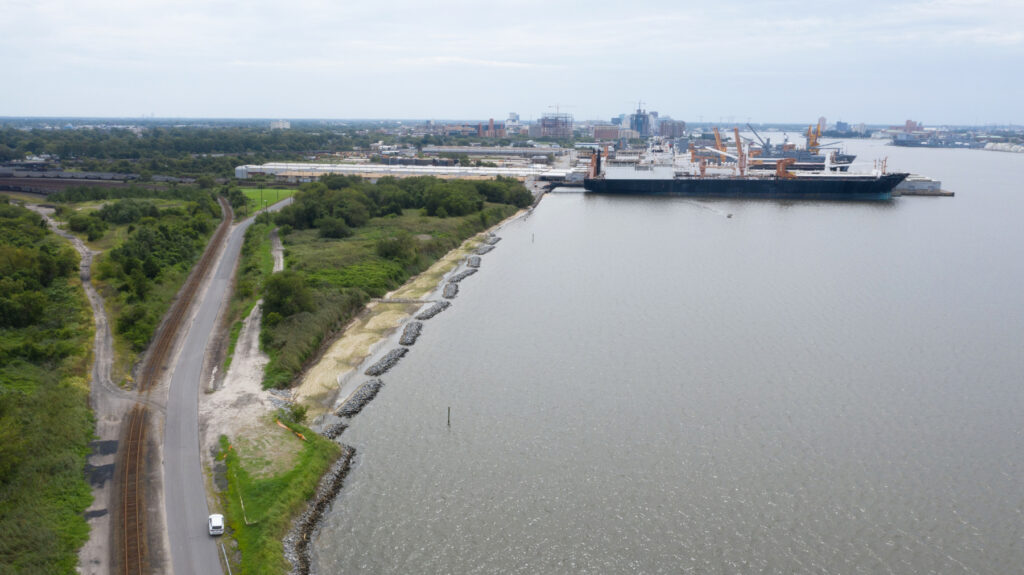All about the community of model railroading and rail enthusiasm
September 3, 2020 / Updated June 26, 2023
NORFOLK, VA (PRNewswire) — Oysters, river otters, shore birds, and other wildlife have a new place to call home along an industrial stretch of the Elizabeth River that Norfolk Southern has reclaimed as a living shoreline.
The innovative sustainability project, completed recently, has transformed a stretch of severely eroded shoreline at the railroad’s Lamberts Point terminal into a green oasis in an area where ship repair and port businesses operate. The initiative advances significant environmental, community, and business goals.

“This project reflects our long-standing commitment to be a good community steward,” said Josh Raglin, chief sustainability officer. “We are restoring habitat that not only beautifies the shoreline and contributes to a healthy river ecosystem, but also will help protect important business assets at our terminal. We view it as a sustainability triple play.”
For years, Norfolk Southern has worked closely with the Elizabeth River Project, a community nonprofit in Hampton Roads whose mission is to restore and preserve the river. The partnership led to the living shoreline, a creative business solution that generates environmental benefits while combatting erosion that in the future could threaten an access road and tracks at the Lamberts Point terminal. In a region impacted by rising tides, this natural approach will provide better long-term protection and is more cost-efficient than hardening the shoreline with rocks – a common engineering solution of the past.
“This is one of the region’s largest living shorelines created by a business on the river,” said Marjorie Mayfield Jackson, executive director of the Elizabeth River Project. “Norfolk Southern’s project is entirely voluntary and is a great example of a corporation giving back to a river it depends on. For a region that is wrestling with sea-level rise and adaptation, it’s really a great model for others on how you can bring back a beautiful, vibrant shore and also contain future erosion.”
The restored shoreline site is roughly nine acres and extends along the shore at a length of nearly three football fields. Before the project, broken pilings and pieces of bulkhead poked above the river and waves had scoured away the beach, leaving steep, 15-foot-tall cliffs.
Now, the shoreline is restored with more than 2,300 cubic yards of sand, roughly 200 dump truck loads. A series of small rock breakwaters installed near the shoreline break the energy of waves as they roll toward shore.
Around 90 cubic yards of recycled oyster shells are layered on the backside of the breakwaters to create inviting habitat for oysters, known for their ability to clean and purify water. To help stabilize the shoreline and enhance the “living” part of the project, nearly 24,000 plantings of spartina marsh grass, a native saltwater grass, provides wetlands habitat for fish and other wildlife. Eventually, the grasses will grow to be 3- to 5-feet tall.
Norfolk Southern selected Dewberry, a professional services firm with a Virginia Beach office, as design engineer and to manage construction of the living shoreline project. Carolina Marine Structures of Powells Point, North Carolina, constructed the project.
Norfolk Southern participates in the Elizabeth River Project’s “River Star” program, having achieved Model Level status, the highest rating for a River Star business partner. NS has gained that status in large part through environmental projects at the Lamberts Point facility that conserve water and promote a cleaner river.
NS has installed a storm water recycling system at the terminal that collects, treats, and reuses storm water for business processes, saving the city anywhere from 10 to 15 million gallons of water annually.
The living shoreline reinforces the community partnership, Raglin said.
“It’s rethinking how we do business and looking at other options,” Raglin explained. “This was an opportunity for a lower-cost solution that has positive environmental benefits. We think it’s going to be a better option long-term because coastal environments are very resilient if we can re-establish them appropriately.”